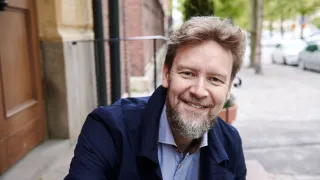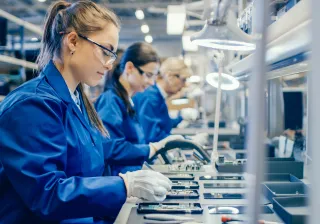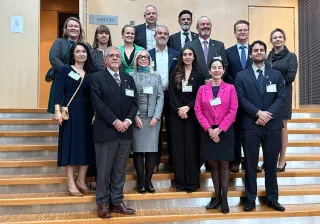Human history over the last 200 years is a series of enormous achievements. While the human population has multiplied in a short time, infant mortality has fallen, life expectancy has increased, and the proportion of people suffering from hunger has declined. In many ways, this positive trend now seems to be coming to an end as the negative side-effects of our achievements are being rapidly amplified.
Why is it that we, in all our wisdom and ability, have not been able to learn from our mistakes but instead have repeatedly created solutions that create new problems?
Kaarlo Hildén , Rector of the University of the Arts Helsinki, is our guest blogger for VTT Futures Perspectives forum hosted by Katri Kallio.
One key reason is our inability to see the world in a systemic way. By sorting, classifying, dividing, and structuring the world, we make it more comprehensible to ourselves. We have benefited from looking at the world in a way that seems logical to us: it has helped us to manage and use it more effectively, leading to unforeseen economic growth.
Since the 1940s, systems theory, and in particular the study of complex dynamical systems, has shown the shortcomings and drawbacks of this simplistic thinking, the consequences of which are threatening the planet and our own existence. Yet in many ways we are still guided by this old linear and divisive thinking, because we are trapped in the benefits it has brought us.
Are we meeting or creating needs?
Our inability to recognise and address the social and cultural aspects of solving sustainability problems is particularly acute – perhaps because they are by nature complex and therefore more difficult to manage and solve through the rational and linear thinking that we have come to rely on as our saviours of the future.
Creating effective solutions to problems is much simpler and more convincing if these complex aspects of human science are excluded. At the same time, we can assume that the outcome will not be as predicted – by ignoring the human actions and behaviours, driven by attitudes, habits, and values, we ignore the most powerful determinant of the future: human beings themselves. For example, any advances in material and energy efficiency can be quickly reversed if our lifestyle choices and market mechanisms simultaneously increase overall consumption.
The thinking that led to these problems may be inherited from the era of exploration and pioneering, when we looked at the world in terms of endless possibilities and untapped resources. We did not recognise that we were part of the system; the world was seemingly made for us. Strangely enough, the same mindset is also reflected in our relationship with our fellow human beings: they are a key resource for commercial activity.
Paradoxically, individualism and humanism have provided a good basis for seeing people as a resource. The ideal of individual freedom and the humanist idea that the individual knows what is best for them provide infinite opportunities for creating new commercially exploitable needs. We have adopted the idea that freedom comes from being able to choose from hundreds of foods, services, and goods that are unnecessary or even harmful to us.
In reality, the huge supply and the ever-growing new needs that marketing has been able to create in us has reduced rather than increased individual freedom, autonomy, and self-direction. Our perception of and interaction with the world is increasingly built on digital information, accumulated and moderated to us by third parties. New technologies have offered novel opportunities to steer and control human thought and relationships in ways that are profoundly changing our societies. With the ever-increasing influence different digital platforms have on our culture and thinking, our values and ideas may not be as individual and original we believe them to be. The basic principles of both democracy and markets are turning upside down when development is no longer driven by the needs of citizens or customers but by those having the power to shape those needs. The competitive edge is not necessarily created by serving people more effectively, as it is equally possible to dominate by being more effectful in shaping how people think and what they value. Technological development is driving cultural evolution, which is raising unforeseen ethical questions.
At the same time, well-being has also been undermined, because the needs addressed often do not originate from within us and satisfying them does not provide a lasting experience of genuine meaningfulness or increased quality of life. Most of our most profound psychological and emotional needs are of such a nature that meeting them is not commercially viable and there is therefore no economic incentive to do so.
Re-evaluating values
Economic steering mechanisms strongly encourage partial optimisation, where the benefits accrue to oneself, and the disadvantages are borne by others. Investments in innovation are made because they are expected to pay back in interest and economic benefits. However, this leads to a situation where it is not worth trying to solve problems that do not have an economic benefit aspect. We have created a negative feedback loop whereby commercially viable investments create problems that are not commercially viable to solve.
For technology to truly serve people, there needs to be a deeper understanding and consideration of what is truly valuable and worth striving for. We need value-driven technological development, based on a holistic understanding of the human being that recognises not only material needs but also psychological needs, such as needs for experiences of purpose, beneficence, dignity, and relatedness.
This is where artistic approaches can be of help, as they can bring forward aspects of the human experience by using methods and sources of information that reach beyond the toolbox of scientific inquiry and conscious thought processes. Artistic thinking is fundamentally holistic; it seeks to draw not only on cognitive and verifiable knowledge, but also on experiential, sensory, emotional, intuitive, embodied, and subjective knowledge. Making use of the imaginative capacity of the unconscious mind and connecting to our values, art can question our ways of understanding, thinking, and experiencing the world, pushing us to reflect on what is right or wrong and asking us difficult questions about what is meaningful and worth striving for, thereby highlighting the dissonances between our values and actions.
Overcoming boundaries
When the way we solve problems is a root cause of the problem, changes are needed at the level of values, mindsets and mental models. Our deeply held beliefs, assumptions and taken-for-granted ways of operating influence how we think, what we do, and how we talk. Shifting these mental models is a prerequisite to achieve the systems change required for creating genuinely sustainable innovations.
We tend to overestimate our cognitive ability to make conscious estimates and choices, based on the facts we are aware of. We may imagine our reasoning to be objective and logical when, in reality, we are unconsciously guided by learned patterns of thought, experiences, motives, and emotions. One of the most frequent reasons for failures in creating genuinely sustainable solutions is that we only target the symptoms, without addressing the root causes that are often on the level of values and mindsets. If the root causes for a problem are, for example, connected to insatiable consumerism and a dopamine-fuelled shopping addiction, an attempt to solve the problem by creating recyclable packaging is only a temporary mitigation of the negative consequences, not a solution to the problem.
If we do not challenge the assumptions lying behind our perception of the problems we are trying to solve, we can easily end up with overly narrow or even incorrect interpretations of the nature and root causes of the problem we are solving. This risk is particularly high when trying to understand cultural, social, and psychological factors. If problem-solving is based on a simplistic mechanistic and materialistic understanding of what is important and meaningful to people, development activities can lead to unforeseen negative social and psychological consequences. We need the creative and holistic approaches of the arts and humanities to open the floodgates of our thinking and imagination, helping us to broaden our understanding of problems and meaningful solutions.
We also need to better understand how cultural, social, and psychological factors influence the adoption of innovations and new technologies. It is essential to understand how, for example, habits, motivations, and values drive human behaviour, affecting whether or not the desired outcome is achieved. Truly sustainable solutions often require not only new technologies but also changes in our values and in the way we perceive the world. Scientific knowledge needs to be accompanied by the experiential nature of art and its ability to touch us and shake our thinking to enable the transformational cultural shift that a sustainable future requires.
Thirdly, we need a deeper understanding of how different technological innovations respond to our real needs. If a solution serves us economically, but the benefits are unevenly distributed or the value it adds to our fundamental experience of a meaningful and dignified life is questionable, we may wonder whether it is a solution or rather part of the problem. Artistic approaches can offer us ways to contemplate on what is ultimately worth striving for. We are in a dire need of collective experiences of awe, provoking modifications of the mental constructs that we use to understand the world, rearranging our priorities and helping us to imagine pathways to sustainable futures.
Kaarlo Hildén, Rector of the University of the Arts Helsinki, has more than two decades of experience in helping expert organisations as a board member, consultant and manager. His areas of interest include art & educational policies, organizational dynamics, complex systems, and sustainable innovation.







